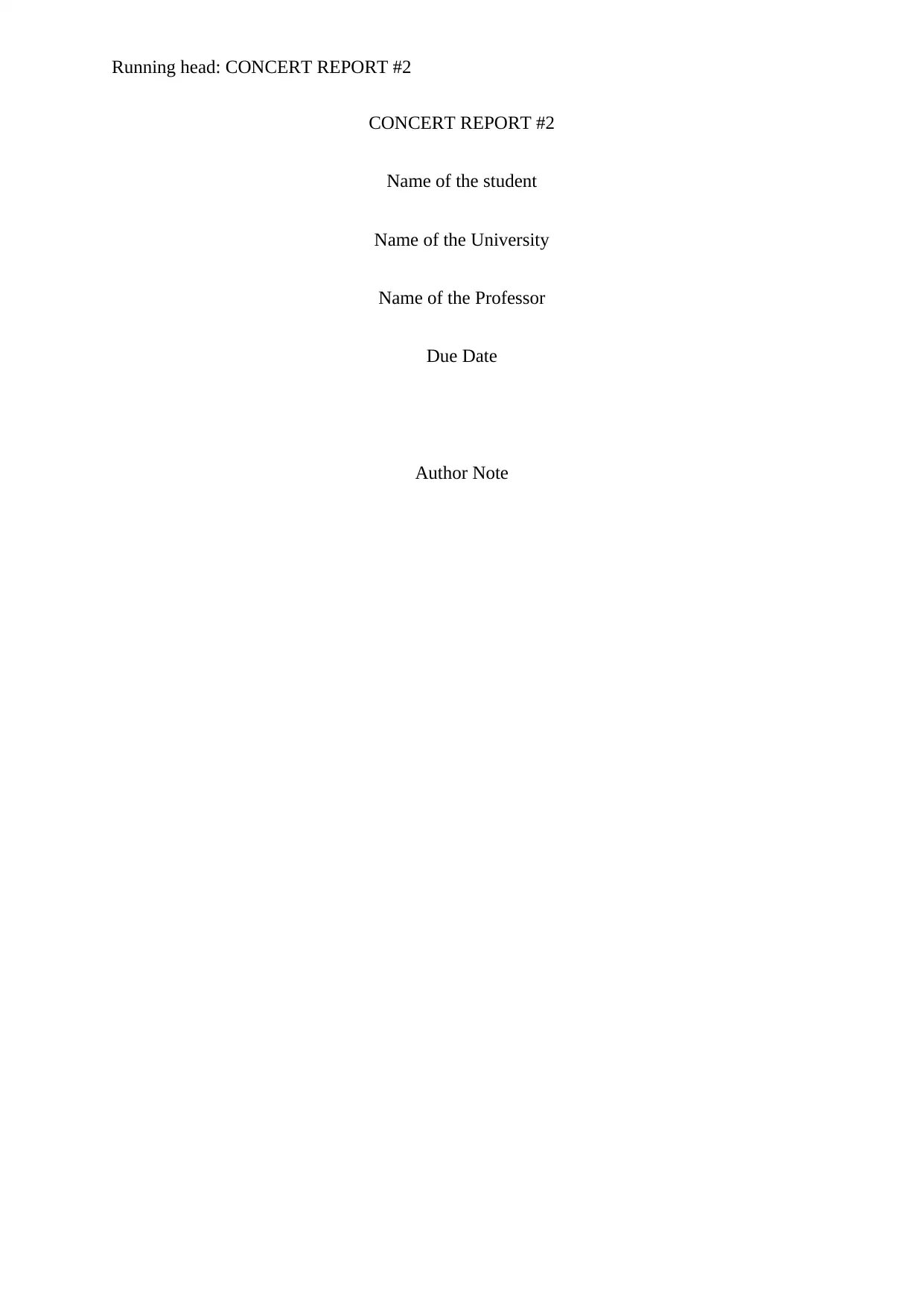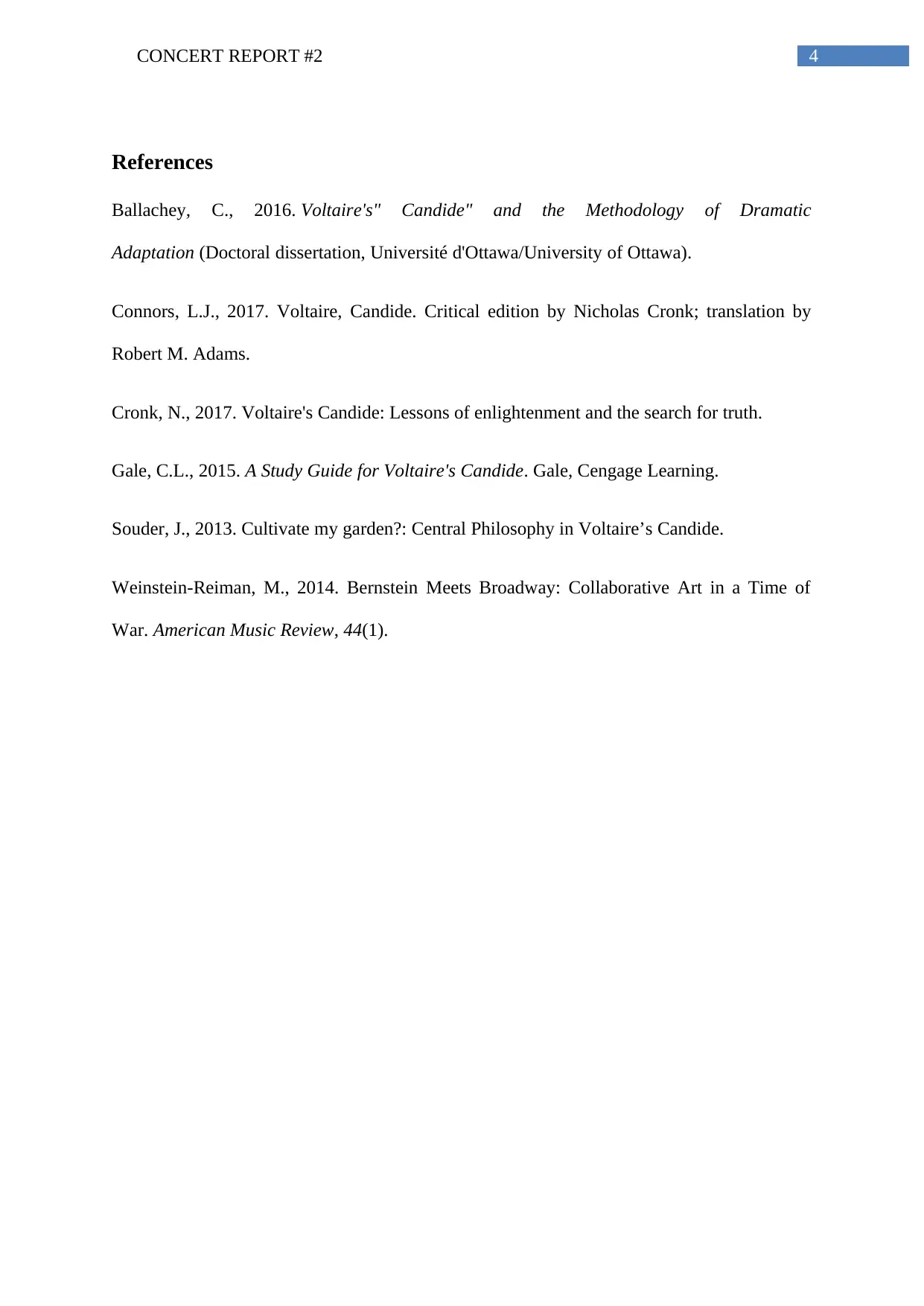MUAR 211 Art of Listening: Detailed Report on Bernstein's 'Candide'
VerifiedAdded on 2023/06/14
|5
|1067
|472
Report
AI Summary
This concert report reviews Leonard Bernstein's operetta 'Candide', analyzing its historical context, performance, and reception. Originally a failure on Broadway, the operetta's various revisions and L.A. Opera's production are discussed. The report highlights the performances of Kelsey Grammer and Christine Ebersole, the set design, and key musical numbers like 'The Best of All Possible Worlds' and 'Oh Happy We'. Despite the talented cast and notable compositions, the reviewer concludes that 'Candide' still struggles to engage audiences on a dramatic level, ultimately deeming it a heartbreaking failure due to the plot's deep issues not matching the execution of the performance.

Running head: CONCERT REPORT #2
CONCERT REPORT #2
Name of the student
Name of the University
Name of the Professor
Due Date
Author Note
CONCERT REPORT #2
Name of the student
Name of the University
Name of the Professor
Due Date
Author Note
Paraphrase This Document
Need a fresh take? Get an instant paraphrase of this document with our AI Paraphraser

1CONCERT REPORT #2
Introduction
This paper aims to review the operetta, ‘Candide’, where the American composer
Leonard Bernstein composes the music and it is based on the novella Voltaire, written in
1759 (Gale 2015). It is often considered a satire in nature (Weinstein-Reiman 2014). The
operetta was performed for the first time in the year 1956. The first performance of the
operetta consisted of a libretto by American dramatist and screenwriter Lillian Hellman.
However, since the year 1974, the operetta has been performed with the book written by
Hugh Wheeler. This was due to the fact that Hugh Wheeler’s book was more precise to the
original source material Voltaire (Connors 2017). The lyricists of the operetta were Richard
Wilbur, Dorothy Parker, Lillian Hellman, John Latouche, Stephen Sondheim and lastly,
Leonard Bernstein. The show consisted of an ensemble of strings, woodwinds, brass,
percussion along with soprano, alto, tenor and bass singers.
Critical Review
The first time Candide was performed in Broadway in 1956, it was devastating
failure. Although it had a score which would attract a lot of listeners and admirers, it still was
a failure in terms of the number of audiences. The original libretto written by Lillian hellman
had undergone changes made by many writers over the years, in order to fix the main
drawbacks of the show. However, even after the changes and contributions made by almost 7
writers, Candide was still considered a failure. Therefore, when the show opened under the
L.A Opera’s production, directed by the creative Francesca Zambello, hopes were high that
the results would differ at this time. The cast consisted of the talented Broadway actors
Kelsey Grammer and Christine Ebersole.
Introduction
This paper aims to review the operetta, ‘Candide’, where the American composer
Leonard Bernstein composes the music and it is based on the novella Voltaire, written in
1759 (Gale 2015). It is often considered a satire in nature (Weinstein-Reiman 2014). The
operetta was performed for the first time in the year 1956. The first performance of the
operetta consisted of a libretto by American dramatist and screenwriter Lillian Hellman.
However, since the year 1974, the operetta has been performed with the book written by
Hugh Wheeler. This was due to the fact that Hugh Wheeler’s book was more precise to the
original source material Voltaire (Connors 2017). The lyricists of the operetta were Richard
Wilbur, Dorothy Parker, Lillian Hellman, John Latouche, Stephen Sondheim and lastly,
Leonard Bernstein. The show consisted of an ensemble of strings, woodwinds, brass,
percussion along with soprano, alto, tenor and bass singers.
Critical Review
The first time Candide was performed in Broadway in 1956, it was devastating
failure. Although it had a score which would attract a lot of listeners and admirers, it still was
a failure in terms of the number of audiences. The original libretto written by Lillian hellman
had undergone changes made by many writers over the years, in order to fix the main
drawbacks of the show. However, even after the changes and contributions made by almost 7
writers, Candide was still considered a failure. Therefore, when the show opened under the
L.A Opera’s production, directed by the creative Francesca Zambello, hopes were high that
the results would differ at this time. The cast consisted of the talented Broadway actors
Kelsey Grammer and Christine Ebersole.

2CONCERT REPORT #2
Kelsey Grammer performs at his best as the narrator with essential voice modulations.
The show demands a migrating nature of narration and Grammer is energetic in keeping the
narrative flowing. The actor gives his best in the role of Pangloss as well with a few note
worthy moments of performance. Christine Ebersole plays the ‘Old Lady’ with the songs
being performed by Andrea Martin, Linda Lavin, Judy Kaye and Patti LuPone. The show
tries its best to provide a taste of diversity in its performance, which often leads to a rough
transition in its plot.
Candide is the name of the main protagonist, and the show portrays the various
gruesome adventures that the he experiences while in search of the love of his life,
Cunegonde (Ballachey 2016). Throughout his journey, Candide confronts the Bulgarian
army, the Spanish Inquisition and even pirates at the sea. However, he finally travels via the
river to reach El Dorado only to find Cunegonde living her life in great misery, both as a
victim of rape and prostitution. It is in the end that Candide experiences a burst of optimism
in him, and states that even when everything goes wrong, life must still go on (Souder 2013).
The set is designed carefully by James Noone and the performance takes place under
the proscenium of an abandoned theatre. Almost all furnitures are covered in white sheets,
along with the presence of picture frames that are empty. The narrator positions himself
among books and a classical bust with a skull being placed in the shelf, adding to the
intensity of the atmosphere (Cronk 2017). The show opens with the song ‘The Best of All
Possible Worlds’, and is soon followed by the duet ‘Oh Happy We’, by the main characters
Candide and Cunegonde. The duet is charming in nature and perfectly portrays the
differences between the newly-weds through its clever use of the lyrics. Halfway through the
show, Ebersol’s arrival brings a breath of fresh air to the show and her performance as the
Old Lady with only one buttock, is remarkable to say the least. Ebersole maintains a good
comedic timing and her performance does not disappoint.
Kelsey Grammer performs at his best as the narrator with essential voice modulations.
The show demands a migrating nature of narration and Grammer is energetic in keeping the
narrative flowing. The actor gives his best in the role of Pangloss as well with a few note
worthy moments of performance. Christine Ebersole plays the ‘Old Lady’ with the songs
being performed by Andrea Martin, Linda Lavin, Judy Kaye and Patti LuPone. The show
tries its best to provide a taste of diversity in its performance, which often leads to a rough
transition in its plot.
Candide is the name of the main protagonist, and the show portrays the various
gruesome adventures that the he experiences while in search of the love of his life,
Cunegonde (Ballachey 2016). Throughout his journey, Candide confronts the Bulgarian
army, the Spanish Inquisition and even pirates at the sea. However, he finally travels via the
river to reach El Dorado only to find Cunegonde living her life in great misery, both as a
victim of rape and prostitution. It is in the end that Candide experiences a burst of optimism
in him, and states that even when everything goes wrong, life must still go on (Souder 2013).
The set is designed carefully by James Noone and the performance takes place under
the proscenium of an abandoned theatre. Almost all furnitures are covered in white sheets,
along with the presence of picture frames that are empty. The narrator positions himself
among books and a classical bust with a skull being placed in the shelf, adding to the
intensity of the atmosphere (Cronk 2017). The show opens with the song ‘The Best of All
Possible Worlds’, and is soon followed by the duet ‘Oh Happy We’, by the main characters
Candide and Cunegonde. The duet is charming in nature and perfectly portrays the
differences between the newly-weds through its clever use of the lyrics. Halfway through the
show, Ebersol’s arrival brings a breath of fresh air to the show and her performance as the
Old Lady with only one buttock, is remarkable to say the least. Ebersole maintains a good
comedic timing and her performance does not disappoint.
⊘ This is a preview!⊘
Do you want full access?
Subscribe today to unlock all pages.

Trusted by 1+ million students worldwide

3CONCERT REPORT #2
After a long running time of 2 hours and 30 minutes, and performance by a multi
talented cast, one cannot help but state that Candide is not as engaging as it was assumed to
be and fails to interest the viewers on a dramatic level. Songs like Dear Boy and I Am Easily
Assimilated are undoubtedly the best compositions and the tune would be stuck in one’s mind
for a long time. Bernstein work unluckily, goes underappreciated due to the overall
limitations of the show.
Conclusion
Although the plot deals with deep issues of human emotion, and tragedy yet the
execution of performance somewhat does not match up to the intensity of the plot.
Therefore,it can be concluded saying that, even after so many years, Candide still remains a
heartbreaking failure to which the audience fail to connect to.
After a long running time of 2 hours and 30 minutes, and performance by a multi
talented cast, one cannot help but state that Candide is not as engaging as it was assumed to
be and fails to interest the viewers on a dramatic level. Songs like Dear Boy and I Am Easily
Assimilated are undoubtedly the best compositions and the tune would be stuck in one’s mind
for a long time. Bernstein work unluckily, goes underappreciated due to the overall
limitations of the show.
Conclusion
Although the plot deals with deep issues of human emotion, and tragedy yet the
execution of performance somewhat does not match up to the intensity of the plot.
Therefore,it can be concluded saying that, even after so many years, Candide still remains a
heartbreaking failure to which the audience fail to connect to.
Paraphrase This Document
Need a fresh take? Get an instant paraphrase of this document with our AI Paraphraser

4CONCERT REPORT #2
References
Ballachey, C., 2016. Voltaire's" Candide" and the Methodology of Dramatic
Adaptation (Doctoral dissertation, Université d'Ottawa/University of Ottawa).
Connors, L.J., 2017. Voltaire, Candide. Critical edition by Nicholas Cronk; translation by
Robert M. Adams.
Cronk, N., 2017. Voltaire's Candide: Lessons of enlightenment and the search for truth.
Gale, C.L., 2015. A Study Guide for Voltaire's Candide. Gale, Cengage Learning.
Souder, J., 2013. Cultivate my garden?: Central Philosophy in Voltaire’s Candide.
Weinstein-Reiman, M., 2014. Bernstein Meets Broadway: Collaborative Art in a Time of
War. American Music Review, 44(1).
References
Ballachey, C., 2016. Voltaire's" Candide" and the Methodology of Dramatic
Adaptation (Doctoral dissertation, Université d'Ottawa/University of Ottawa).
Connors, L.J., 2017. Voltaire, Candide. Critical edition by Nicholas Cronk; translation by
Robert M. Adams.
Cronk, N., 2017. Voltaire's Candide: Lessons of enlightenment and the search for truth.
Gale, C.L., 2015. A Study Guide for Voltaire's Candide. Gale, Cengage Learning.
Souder, J., 2013. Cultivate my garden?: Central Philosophy in Voltaire’s Candide.
Weinstein-Reiman, M., 2014. Bernstein Meets Broadway: Collaborative Art in a Time of
War. American Music Review, 44(1).
1 out of 5
Your All-in-One AI-Powered Toolkit for Academic Success.
+13062052269
info@desklib.com
Available 24*7 on WhatsApp / Email
![[object Object]](/_next/static/media/star-bottom.7253800d.svg)
Unlock your academic potential
Copyright © 2020–2025 A2Z Services. All Rights Reserved. Developed and managed by ZUCOL.